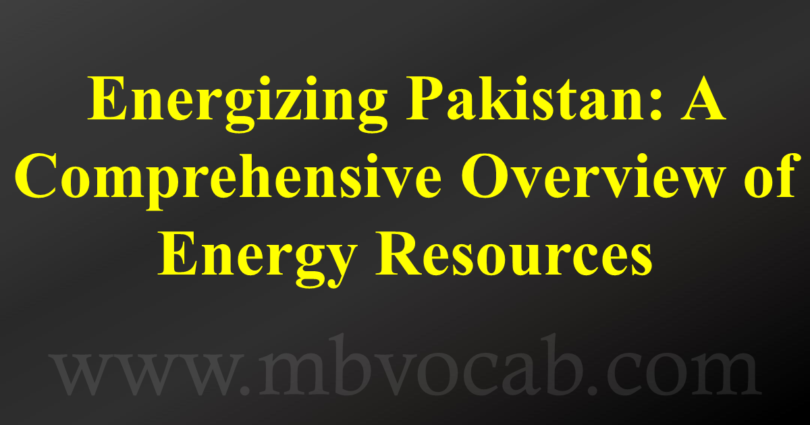Energy Resources: Catalysts of Economic Growth
Energy resources constitute the lifeblood of economic progress. A nation blessed with abundant energy resources experiences accelerated development. However, the mere presence of these resources does not guarantee advancement; it is their strategic utilization that separates prosperous nations such as the United States, France, Britain, and Germany from those that lag behind, including Pakistan, India, and various African countries. The exploration of oil and gas reserves in regions like Saudi Arabia, Kuwait, and the Middle East has ushered in remarkable development. In Pakistan, the exploitation of Sui-gas (natural gas) has contributed significantly to conserving billions of rupees in foreign exchange. Thus, the availability and astute exploitation of energy resources stand as paramount factors in a nation’s economic journey.
The Panorama of Energy Resources in Pakistan
I. Hydroelectric Power
Hydroelectricity, harnessed from the kinetic energy of flowing water, stands as one of the most favored energy sources due to its ease of use. Pakistan boasts abundant natural sites, making it a prime location for hydroelectricity generation. Artificial waterfalls, created on dams, provide the necessary force to drive electricity-generating turbines. In the foothills of the Northern and North-Western Mountains, numerous dams have been strategically positioned. In 1947, Pakistan generated a mere 68 megawatts of hydroelectricity, a figure that soared to 6,670 megawatts by 2014. Domestic users, as well as industrial and agricultural sectors, constitute the primary beneficiaries of this energy source.
Key Hydroelectric Dams in Pakistan:
a. Tarbela Dam: This colossal earth-filled dam on the River Indus at Tarbela ranks as the world’s largest. Construction began in 1968 and concluded in 1976, with its current electricity generation capacity at 3,478 megawatts. It also serves irrigation purposes.
b. Mangla Dam: Positioned on the River Jhelum at Mangla, this is Pakistan’s second-largest hydroelectricity source. Completed in 1967, it presently boasts a production capacity of 1,000 megawatts.
c. Warsak Dam: Located on the River Kabul at Warsak, this dam’s construction commenced in 1952 with support from Canada, reaching completion between 1960 and 1981 in phases. It generates 240 megawatts of hydroelectricity and irrigates about 20 thousand acres of land.
d. Ghazi Barotha Dam: Constructed on the River Indus at Ghazi Barotha, this dam has been generating electricity since June 2004, with a capacity of 1,450 megawatts of hydroelectricity.
II. Thermal Electricity
Thermal electricity plants, also known as thermal power plants, produce electricity by boiling water through the combustion of coal, oil, or gas, resulting in steam generation. Steam pressure drives electricity generators through specialized mechanization. These plants serve as alternatives to hydroelectricity, especially in large urban centers or during hydroelectricity supply interruptions. In Sindh Province, the Karachi Electric Supply Corporation (KESCO) has erected numerous thermal power plants to cater to Karachi’s electricity needs. WAPDA has also established thermal power plants in Hyderabad, Sukkar, Jamshoro, and Guddu in Sindh Province. Punjab features similar plants in Rawalpindi, Lahore, Faisalabad, Kot Addu, Muzafargarh, and Multan. In Balochistan, thermal power plants can be found in Quetta, Pasni, and Hub.
III. Nuclear Electricity
Pakistan commenced nuclear energy generation in 1971 with its first nuclear power plant in Karachi, developed in cooperation with Canada, boasting a power generation capacity of 137 megawatts. A second nuclear power plant has been established near Mianwali at Chashma, capable of generating 300 megawatts.
IV. Natural Gas
Commonly referred to as fuel gas, natural gas ranks as the second-largest energy source, following electricity. Renowned for its cleanliness and environmental friendliness, it is extensively used. Natural gas exploration in Pakistan began in Sui, Balochistan, in 1952, hence its colloquial name “Sui Gas.” Approximately one-third of Pakistan’s energy needs are met through natural gas, primarily as a household fuel. The fertilizer industry heavily relies on natural gas, and it is increasingly utilized as a vehicle fuel, known as Compressed Natural Gas (CNG).
Gas reserves have been unearthed in all four provinces. Balochistan features significant reserves in Sui, Pirkoh, Zin, and Uch. In Punjab, coal reserves are found in Dharnal, Toot, Dhulian, Mial, and Dhodak, while Sindh offers Sari, Mari, Kandkot, Khanpur, Hundi, and Mazarani areas. Khyber Pakhtunkhwa boasts reserves in Kohat and Darra Adam Khel.
V. Coal
Pakistan’s coal resources are characterized by their lower quality. They are primarily used as household fuel and in brick kilns. Coal mining commenced in 1887, and it is now extracted in all four provinces:
- In Punjab, coal is found in Makarwal, Dandot, Pidh, and Kalabagh.
- Balochistan features coal deposits in Sorange, Khost, Shahreg, Harnai, Chamalang, Degari, Dukki, and Mach, with relatively better quality coal used in Pakistan Steel Mills, Karachi.
- Sindh hosts the majority of the country’s coal production, with Lakhra, Jhempir, Meting, and Thar boasting substantial deposits. Projects are underway to utilize Thar’s coal for electricity generation.
- In Khyber Pakhtunkhwa, coal mining occurs in Kohat and Darra Adam Khel, a renowned area in Orakzai Agency.
VI. Mineral Oil (Petroleum)
Mineral oil, commonly known as petroleum, is a cornerstone of global energy sources. It serves as a vital component in aviation, vehicular operations, and several industries. Often referred to as “liquid gold,” its significance is akin to that of actual gold. The Potohar Plateau stands as Pakistan’s primary petroleum-producing region. Dhulian, Khore, Mial, Balkasar, Joyameer, Sarang, and other areas in this region have been sources of petroleum extraction for several decades. Petroleum reserves have also been explored in Dhodak (D.G. Khan) and Khaskheli (District Badin). However, indigenous reserves fall short of meeting national demands, necessitating petroleum imports.
Karachi hosts two oil refineries, “Pakistan Oil Refinery” and “National Oil Refinery.” Additionally, a refinery in Mahmood Kot refines crude oil from the Dhodak area.
VII. Non-Conventional Energy Resources
Energy is pivotal for progress in urban and rural settings, agriculture, industry, and the arts. Recognizing the finite nature of conventional energy resources like wind energy, nations are actively exploring non-conventional alternatives. These resources include bio-gas, solar







